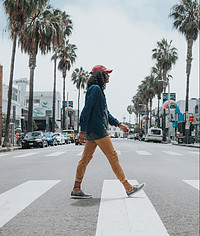I recall when our grandson was first diagnosed with type 1 diabetes back in June of 2019 I did not understand what is a diabetic diet plan.
Of course, I figured just eating mostly healthy should cover it.
I didn’t realize there was so much to be considered when feeding a type 1 diabetic.
Eating a healthy, well-balanced diet and ensuring you get daily exercise is important for everybody but is especially important for diabetics.
I was always big on meal planning, then buying my week’s groceries so I would have everything I needed in my refrigerator or pantry.
Now that we have a diabetic grandchild, I like to plan for sleepovers or visits well in advance so I can plan the meals and snacks around Alex’s needs.
It really isn’t all that difficult and isn’t any different than any healthy meal plan, with the exception of having regular meals and snacks, counting carbs and injecting insulin.
So let’s dig a little deeper.
Table of Contents
What is a meal plan?
So, what is a meal plan and why do I need one?
Simply put, a meal plan is a guide for what, when and how much to eat for maximum nutrition while maintaining blood sugar levels within your target range and hopefully having fewer fluctuations.
To make it sustainable, you must consider your goals, tastes and lifestyle as well as all medications you are taking.
When you eat regular, balanced meals, it can help you avoid really high or really low blood sugar levels.
It can also be helpful to eat about the same amount of carbs at each meal.
Different food affects our bodies differently.
Carbohydrates can raise blood sugars both higher and faster than protein or fat.
Fibre can help you manage your blood sugar.
Eating carbs with fibre in them won’t raise blood sugars as fast as carbs without fibre.
What to Eat
When you are first diagnosed your doctor will likely refer you to a dietician and/or a certified diabetes educator. They will help you determine the best meal plan for you.
They will take into consideration any special dietary needs, or allergies, whether you want to lose or maintain weight and what medications you are taking.
The easiest way to ensure you are eating a healthy, well-balanced diet is to make sure you eat a variety of fruits, vegetables, proteins, carbohydrates and healthy fats each day and get regular exercise.
Carbohydrates
Contrary to popular belief, diabetics can and should eat carbohydrates. The trick is to choose healthy carbohydrates.
Some carbohydrates can significantly raise the blood sugar levels quite quickly while others don’t raise the blood sugar as much and at a much slower rate.
Choosing healthier options will help in preventing those post-meal blood sugar spikes.
Choose carbs that are packed with fibre (and don’t spike your blood sugar)
Instead of… Try these high-fibre options…
White rice Brown or wild rice, riced cauliflower
White potatoes (including fries and mashed potatoes) Sweet potatoes, yams, cauliflower mash
Regular pasta Whole-wheat pasta, spaghetti squash
White bread Whole-wheat or whole-grain bread
Sugary breakfast cereal High-fiber, low-sugar cereal
Instant oatmeal Steel-cut or rolled oats
Cornflakes Low-sugar bran flakes
Corn Peas or leafy greens
Our grandson is a type 1 diabetic which means he requires daily insulin injections.
Alex’s diabetes care team has come with a formula for us to calculate his insulin dosage for each meal based on the number of carbs eaten.
For this reason, we had to learn to count his carbs. That means we weigh or measure all his carbs to ensure we calculate his insulin correctly.
So yeah, a measuring cup and kitchen scale have become an important part of each meal. Reading nutrition labels on everything has also become extremely important.
Protein
Proteins are amazing because they help us feel full for longer. Be sure each meal contains a source of protein.
Healthy protein includes:
- beans
- eggs
- meats
The best sources of meat protein are chicken and fish. Lean red meat is ok occasionally. Try for once a week or maybe even once a month like on the Mediterranean Diet.
Fats
Yes there are healthy fats including:
- nuts
- seeds
- avocado
Despite the fact that proteins and fats won’t directly raise your blood sugar, eating too much of them can have other harmful effects, particularly heart disease.
It is recommended to limit your intake of processed or fatty meats because they contain higher amounts of saturated fat and sodium.
Fruits & vegetables
Vegetables like potatoes, corn, peas, and beans contain starch which is a form of sugar. Starchy vegetables contain more carbohydrates than other vegetables. Eat starchy vegetables in moderation and account for them when calculating your carbohydrate intake.
Examples of starchy vegetables that contain15 grams of carbs:
- 3 ounces of a baked potato
- 1/2 cup of corn
- 1/2 cup of sweet potatoes or boiled potatoes
- 1/2 cup of peas
- 1/2 cup of winter squash
Non-starchy vegetables are considered “free” and you can have as much as 3 cups without having a major impact on your blood sugars.
- green leafy vegetables
- asparagus
- beets
- carrots
- celery
- cucumber
- onions
- peppers
- tomatoes
- sprouts
Be sure to select vegetables without sauces. Sauces always contain sugars and other carbs that can spike blood sugars. If you do choose a sauce try to cut back on other carbs that meal.
How much to eat
This is where many people run into trouble, especially when eating out.
Restaurants, especially in North America are known for serving portions that are more comparable to three or four servings.
It is important to fully understand what a portion size is so you can accurately understand just how much food you are eating and make adjustments accordingly.
I am not diabetic but I find restaurant servings too large and will often order from the seniors’ menu or the child menu. These offer much smaller serving sizes and the food is just as good.
Let’s learn about portion sizes
The Plate Method
 This is a visual way of ensuring the proper balance of foods on your plate.
This is a visual way of ensuring the proper balance of foods on your plate.
Start with a 9 – inch dinner plate:
- Fill half with non-starchy vegetables such as salad, green beans, broccoli, cauliflower, spinach, cabbage or carrots
- Fill one quarter with lean protein such as chicken, fish, turkey, beans, tofu, or eggs
- Fill the last quarter with a starchy carb such as potato, pasta or rice
The plate method can ensure the proper balance of nutrients but it still doesn’t really tell you how much food you should be eating.
Check out this handy guide for portion sizes. It works well to help you visually know how much food to eat. Works great in restaurants too, simply stop eating once you have eaten the appropriate portion size. Or at least acknowledge how many portions you are actually eating.
Portion sizes
Portion size and serving size aren’t always the same thing
- 3 ounces of meat, fish, or poultry
The palm of the hand (no fingers)
- 1 ounce of meat or cheese
Thumb (tip to base) - 1 cup or 1 medium fruit
Fist - 1–2 ounces of nuts or pretzels
Cupped hand - 1 tablespoon
Thumb tip (tip to 1st joint) - 1 teaspoon
Fingertip (tip to 1st joint)
Keep a Food diary
Every three months our grandson’s doctors want to check his Glycated hemoglobin (HbA1c) levels.
This is a test that essentially determines how well his diabetes has been managed over the last 2 – 3 months.
The results of this test determine whether to make changes to his treatment plan or not.
Keeping a food diary gives the doctors and you more information to work with.
If your HbA1c levels are too high, reviewing your food diary may help give clues as to why.
You may need changes in diet or perhaps increased insulin.
The information you will want to record is:
- a serving size
- how many servings you ate
- carbs per serving
- fibre per serving
- total calories (if you are trying to lose weight)
Be sure to eat 3 meals per day and up to 3 snacks.
Our grandson is in school through the week and has breakfast at home, morning snack and lunch at school and afternoon snack, supper and bedtime snack at home.
We have found he requires these snacks because he can’t eat enough food at one time to last all the way until the next meal without his blood sugars dropping too low.
The snacks really help keep him stable.
Always work with your diabetes care team to determine the best meal plan for you.
Get Daily Exercise
Daily exercise is another important part of healthy living and diabetes management.
Start with just a daily walk for 15 minutes each and build up from there.
In summer you could go swimming or bicycling.
In winter there is skating, snowshoeing or skiing.
Or you could join a sports team once this COVID is over.
Be sure to test your blood sugars before, during and for up to 12 hours after exercise to learn how your body reacts to exercise.
Again, I stress the importance of working with your diabetes care team on what exercise and how often is best suited to you.
Final Thoughts
We now have a better understanding of what is a diabetic meal plan.
We have learned that by eating a healthy, well-balanced diet we can help avoid extreme blood sugar spikes at mealtimes.
We have learned that type 1 diabetics must count their carbs in order to properly dose their insulin.
Regular exercise will also help manage blood sugar levels.
It is important to eat 3 meals and up to 3 snacks each day.
There is a wide variety of foods to choose from and your diabetes care team will help you determine the best meal plan for you.
I am not in any way a medical practitioner, please do not rely on the information on our website as an alternative to medical advice from your doctor or another healthcare provider. We only share our experiences. We are affiliates, this means that if you purchase something from a link or ad on this site we may receive a small commission. This in no way affects the price you pay.
Do you follow a diabetes meal plan?
Are you working with your diabetes care team?
How is it working out for you?
Leave your answers in the comment section below.


I am not a diabetic, nor I have family with type 1 diabetes, it’s type 2 diabetes for us. Nevertheless, your tips on how to accomplish a diabetic diet plan is good for both types.
I work in healthcare and we cannot over emphasize that diet, exercise and lifestyle changes, together with medications are the keys to effective diabetes management.
Your article is so helpful.
Marita
Thank you, Marita.
I really appreciate a healthcare worker taking the time to comment on my site.
I agree that a healthy diet, regular exercise and making healthy lifestyle changes are important for everyone regardless of diabetes.
In many cases, type 2 diabetes can be avoided by making those essential lifestyle changes.
Take care.
These are great tips and I will pass them on to my friend who is diabetic. He didn’t always take care of his diet, but he does now. He’ll be happy to read this. Is cauliflower recommended for diabetics or only in moderation?
The good thing is that there are still many foods one can eat with diabetes, but you need to stick to the diet. My friend found that out the hard way …
Hi Christine, thank you for passing on the tips in my article.
I am glad to hear your friend is now taking care of his diabetes, it is so important if you want to avoid the many complications of diabetes.
You are correct that there are plenty of foods a diabetic can choose from.
In fact, I have found the Mediterranean Diet to be a very healthy and delicious way of eating.
We mainly follow that plan for ourselves as well as our grandson when he is here.
We still have the occasional sweet but that is the key. It is for an occasion, not every day.
Yes, diabetics can have the occasional sweet, just cut back on other carbs that meal if you want to have a dessert.
Cauliflower is great for diabetics. In fact, I make a lot of stir fry and put it over cauliflower rice instead of regular rice, tastes wonderful and is very healthy and diabetes-friendly.
Thanks again and take care.
Diabetes, is becoming common in the community I live in. I am from Africa, and live in Africa. We have recently seen much people being diabetic and some dying from diabetes in the community I live in. A healthy meal plan for diabetes would help in such a situation, I think. I am really glad to be reading this.
Hi Nelson, I am sorry to hear that there is such an increase in diabetes within your community.
Unfortunately, untreated diabetes can and does lead to complications such as heart disease, stroke, blindness, amputations and even death.
The good news is that type 2 diabetes and diabetes complications can often be avoided by eating a healthy, well-balanced diet, and getting regular exercise.
These things are important for any healthy lifestyle regardless of a diabetes diagnosis.
I am glad my article has helped you understand what you can do to keep yourself as healthy as possible.
Take care of yourself.
A diary is an excellent way, especially if the diabetes journey is a new one. This should be coupled with testing to see how what we eat affects our number and if we have enough information, we know what to eat and how much at future mealtimes.
Do you know what is interesting? The above information from this article is good for general health. It will also help to lower blood pressure and it is great for weight loss too. This means that inflammation will be reduced and so too will arthritis and the list goes on. Great article. Thanks.
Josephine, you are so correct that a food journal is such a helpful tool in managing diabetes.
It is important to understand how your body responds to various types of food so you can make the best choices for you and a food journal can certainly help with that.
We have a son who has Celiac disease and anything containing gluten has adverse effects for him. Type 1 diabetics are at a heightened risk of also developing Celiac or other auto-immune diseases.
The combination of a healthy diet, regular exercise and a food journal is a great way for anyone to stay on track with their health goals regardless of diabetes.
It can be a great help when trying to lose weight, maintain weight or just make healthier choices. The health benefits are incredible.
Thanks again and take care.
This is a great article you wrote. I am sure it will help a lot of people, thank you for sharing.
You are very welcome, thank you for dropping by and leaving a comment on my article.
Have a great day